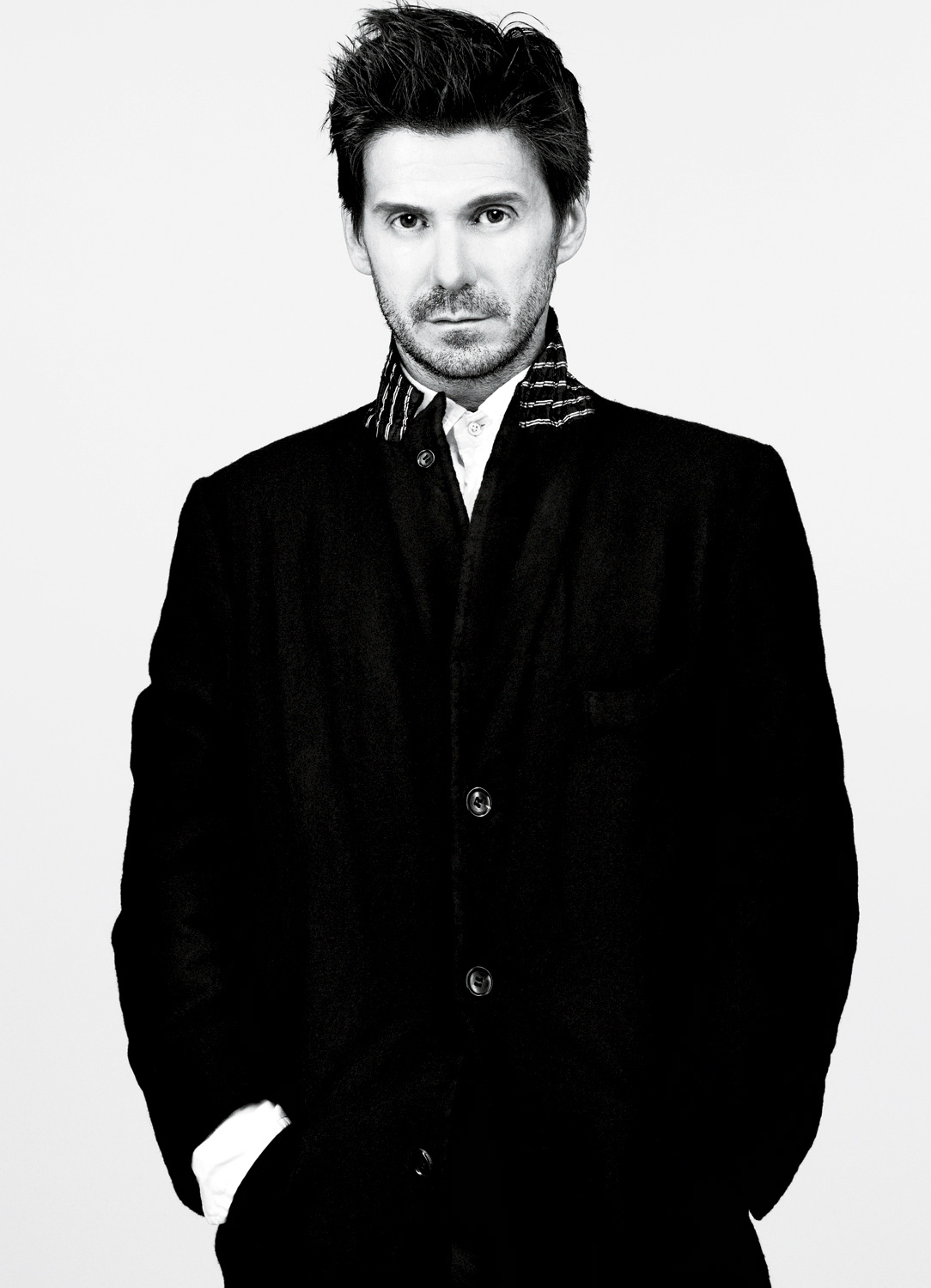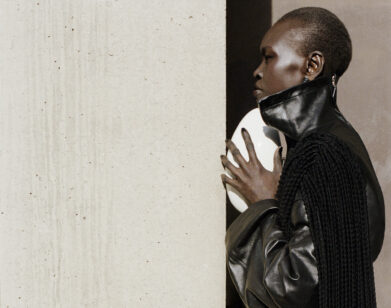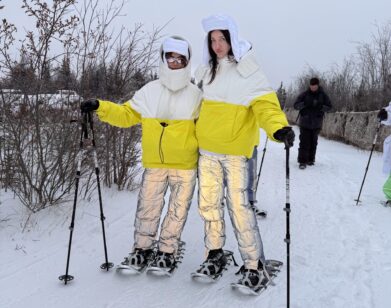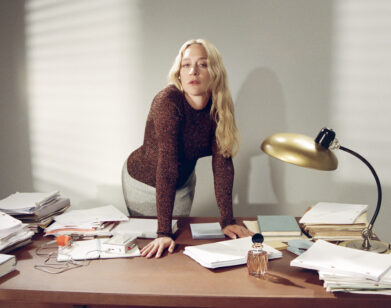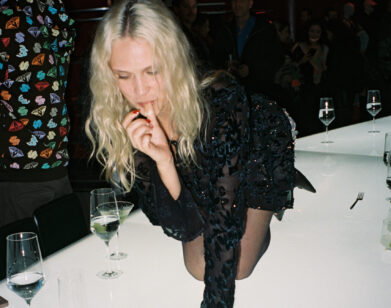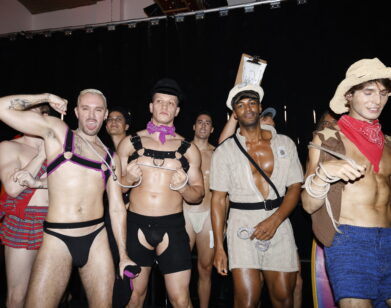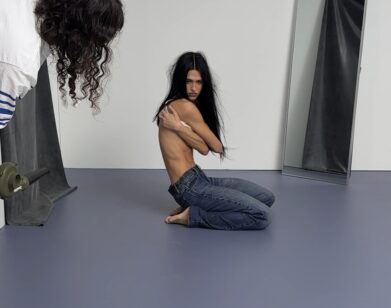Guido
“Hair Stylist” doesn’t really seem an apt job description for Guido Palau’s chameleonic feats of coiffure wizardry. The dominatrix ponytails on the Fall 2011 runway at Marc Jacobs? Guido’s. The just-stepped-out-of-the-shower hair at Roberto Cavalli? Guido’s. Those center-parted Balenciaga blondes? Guido’s too. The Spanish-Anglo hair stylist, known to practically everyone as “Guido,” who hails from the seaside county of Dorset, England, was once unceremoniously released from an apprenticeship at Vidal Sassoon in London in the mid-’80s—legend has it that management didn’t take too kindly when he decided one day to fill the appointment book with bold-face names like Barbra Streisand, who did not in fact have appointments. Later, another door opened when a friend who was photo-assisting, David Sims, decided to strike out on his own and asked Guido to collaborate on sittings. With Sims behind the camera and Guido on the hair, the two men would go on to help create a visual signature, most notably in the pages of the late British style bible The Face, that came to define the proto-It Brit androgynous grunge movement of the early ’90s—an anti-fashion aesthetic that found its way into Calvin Klein’s pivotal Fall 1994 show, for which Guido did his first major runway work and the subsequent ad campaign featuring a then-20-year-old Kate Moss.

Since then, Guido has not only become one of the world’s most in-demand hair stylists, but also one of the most influential image- makers in fashion, lending his deft, rarified touch to upwards of 30 shows a season, as well as numerous campaigns and editorial shoots. Undoubtedly, though, one of Guido’s enduring collabora- tions was with the late Alexander McQueen, which began during McQueen’s tenure at Givenchy in the late ’90s, and has continued with McQueen’s eponymous line, beginning with his literally on- fire Joan of Arc–themed Fall 1998 show, for which Guido wove the models’ hair through skull caps, to the amphibious sculptural coifs for his Plato’s Atlantis Spring 2010 show. Since McQueen’s death in February of last year, Guido has also helped keep the designer’s iconoclastic spirit alive, crafting 75 intricate, face-obscuring masks for the McQueen retrospective, “Alexander McQueen: Savage Beauty,” which opened at the Metropolitan Museum of Art this past May under the guidance of McQueen’s longtime right-hand woman and successor, Sarah Burton. Those Goody barretted hel- met heads at Burton’s sophomore outing for McQueen? Guido’s. Burton, who was at work at her studio in London, recently con- nected with Guido during a break from a shoot in New York.
SARAH BURTON: At what point did you know that you wanted to work in fashion?
GUIDO PALAU: Well, I didn’t know I wanted to be a hairdresser. I was always interested in fashion and imagery in a very naive way, but it was always an attraction, like glitter balls. This was in the late ’70s, early ’80s, so it wasn’t like today, where you kind of know all about the industry. Fashion was a very insider industry then—it was very closed. So I didn’t really know what I wanted to do. I didn’t do great in school. I didn’t have many options. I mean, I’d like to have gone to art college, but I didn’t have the grades. I didn’t have any qualifications. But I had some friends who were hairdressers, so I just thought, Well, I’ll have a go at it. I got into hairdressing and moved from Dorset to London, where I got an apprenticeship at Vidal Sassoon. This was around ’83 or ’84. I was working on South Molton Street, which was then the epicenter of all the shops. It was like a catwalk. So I did my apprenticeship there, but I wasn’t successful. I got fired.
BURTON: So what did you do next?
PALAU: I worked at a bunch of other salons, and at one, this girl was going out to do a photo shoot for a women’s magazine and brought me along to assist her. I remember going on that shoot and thinking, “God, this is great. It’s creative, and you get to work with all of these other creative people.” At that point I decided that hair would be my in to fashion and all the things I thought I would enjoy—and did enjoy.
BURTON: In a way, you really learned on the job. You had no real formal training.
PALAU: I worked in salons, where you do learn the basic sort of thing. But no, I didn’t know anything about the kinds of things I’m doing now. I learned how to put hot-rollers in. [laughs] But I learned other things as I went along. Obviously, I wasn’t as confident and creative in the beginning as I am now, so it was all very safe. But I was building my work, and it took me a long time. For a good five or six years I was just kind of bobbing around, doing everything and anything.
BURTON: Which can be a good thing because it forces you to learn to challenge yourself very early on. When did you start working for The Face and magazines like that?
PALAU: It was in the late ’80s and early ’90s. When you look back at your career, there are moments that are levels that you hit and you bounce off them. One of those for me was meeting David Sims. I met David very early on—I think it was in 1990. He was an assistant then, and he was just starting to do pictures, but he taught me another way of looking at beauty and fashion and the business. So we started working for The Face together and that whole grunge movement of the early ’90s came out of that. It was like a new kind of aesthetic in fashion and beauty, and I think it was a real confidence boost, because it was our thing—people couldn’t question it.
IT MIGHT SOUND a LITTLE BIT KINKY, BUT YOU ALMOST HAVE to BECOME THE WOMAN in YOUR HEAD—HOW she WOULD FEEL. YOU have TO HAVE some EMOTIONAL ATTACHMENT for it TO really WORKGuido Palau
BURTON: That must have been really exciting in so many ways.
PALAU: It was very empowering for everyone who was involved because it wasn’t something that we were copying. Before, I probably was copying the styles of other people and referencing their work, but suddenly this was a primarily English movement that was creating a whole new kind of feeling. It wasn’t solely British because it did have roots in Seattle and New York as well, but obviously, with Kate Moss and that whole thing, it really felt like an English anti-movement, which the Brits are so good at doing.
BURTON: And there was a real questioning of what people’s perceptions of beauty were at the time.
PALAU: Completely. The Brits always favor the underdog. There’s an eccentricity to us, and I think you can see that through the fash- ion and the music and the way people look. In the ’80s, there were so many youth cults happening, and being around them really embedded that kind of style. I always still try to bring that into what I do. Then that early-’90s thing was taken onboard by America. Calvin Klein was a very big supporter of that look, and Kate became his muse, and we all went to work for him. I must say, he really took us Brits under his wing and brought us to America.
BURTON: In some ways, nothing like that has really happened since then. Because of the Internet, everything is so accessible now, but what was happening back then felt very special and so new and so fresh because it was its own thing.
PALAU: I think it was an anti-thing. We’d just come out of an era of Thatcherism in Britain, and then suddenly everything politically was changing. When things really take hold like that and mean something, it’s normally because there’s a bigger change in what’s going on in the country—it’s not just a whim—and that’s why it sticks. We were coming out of a great period, with all of the supermodels, but going really anti-it and shaking up people’s perceptions of beauty and the way to wear clothes. Suddenly it was cool to have your hair lank . . . It was a whole different way of looking at things, and it shook up the whole industry. Suddenly young people were again coming up with different ideas, radical ideas, and the establishment was starting to take it onboard, so it was obviously very relevant. It really hit at the right time.
BURTON: You have this amazing synergy with David Sims and several of your other long-term collaborators over the years, and as someone who has worked with you, I can say that it’s not just hair that you do. You’re a collaborator in creating the entire vision.
PALAU: To be a good hairdresser, you have to understand what the vision is of the designer or the photographer and then sort of add your thing. I’m very lucky that I’ve worked mainly with two amazing photographers in David Sims and Steven Meisel. With Steven Meisel, I’d looked at his work from afar and always loved it, and when I started to work with him, I was blown away. He taught me so much about looking at women and looking at images. I’ve grown up with David in his world, his aesthet- ics, so I feel very lucky. When you work with great people, you learn—about film, about clothing, about life, about sex. With Lee [McQueen], I had an opinion and a thought, but he would push it. He had that . . . I mean, you know what it was like working with him.
BURTON: Exactly. I know.
PALAU: He’d take you somewhere, and then you’d be like, What’s that about? But then you’d want to learn about it and think, Well, where is that coming from? So you’d be learning about a different era, a different sensibility in beauty . .
BURTON: Challenging yourself. I’m sure working with Lee challenged you.
PALAU: Well, when you respect somebody who has talent like that, whether it’s a designer or a photographer, then you don’t want to let yourself down—but you also really don’t want to let them down. You know what’s so exciting? Even though the industry is very big and there’s lots of money, when it gets down to it, whether it’s a photographer or a designer, as well as a stylist or makeup artist, you’re really only working with maybe four or five people on a project. It’s all quite small and intimate. I know the outside of it is huge now, and there’s an enormous impact that it has on things, but the actual creative thing is still quite small.
BURTON: So when you work with different people, how do you work to capture the kind of woman they’re each trying to create in the photograph or in the show?
PALAU: It might sound a little bit kinky, but you almost have to become the woman in your head— how she would feel. You have to have some emotional attachment for it to really work. Fashion is emotional, and the way women look at it is emotional, so it’s very important to try to connect with a woman’s idea of how she might feel. I’m not saying that everything I do is always tasteful—and maybe it’s not always the normal idea of beauty—but hopefully it’s always an empowering idea.
BURTON: Lee taught me that there are different perceptions of beauty and certain feelings that go along with them, and that it’s not all necessarily about feeling glamorous, but about creating a feeling and inspiring a reaction. With the first collection I did after Lee died, it was very much after talking to you that I understood who the girl was and what she was like inside. It is much more of a passionate thing . . . It’s about caring about that woman and feeling what that woman is, which is what I feel like you always bring to things.
PALAU: When I think of the people I’ve worked with, all of them have great passion, and the passion is what keeps people inspired.
BURTON: Also, I remember very clearly working on Plato’s Atlantis with Lee. You always used to make him laugh. He had so much love and respect for you. I remember being so interested about the clothes and the prints and the jacquard and the engi- neering, and then getting to the show and being completely blown away by how the girls looked. This amazing hair you’d done . . . It locked a bit with the proportions of the dress and the body, but it gave me goosebumps because you’d transformed these women. I thought that was really such an amazing collaboration, with the praying mantis and the Leonardo da Vinci muscles and the plants . . .
PALAU: It’s a double-edged sword because it’s sad— that was Lee’s last show really. But what I think was really fantastic about it is that it was so extreme, yet had such a lightness about it. You couldn’t really make the girls anymore extreme, but it felt so right, and somewhere it all came together with a lightness.
BURTON: It didn’t feel labored, even though I remember Lee working so hard on it. Lee always used to say that you have to know everything about the craft before you can destroy it and challenge yourself. Where do you feel fashion is now? How do you feel about fashion going forward?
PALAU: I don’t know, because fashion now is just so confusing. It doesn’t feel as easy. Fashion seems to be in a much more eclectic place. It’s hard to be shocking now. It’s hard to challenge peo- ple because the Internet has allowed everyone to become much more worldly, much more visual. It’s very hard to surprise people. I’m not saying that it’s still not done, but it’s a lot harder. But I think there are still surprises to be seen. I’m not giving up on my work. I’m still trying to challenge people’s aesthetics and myself. You just get your inspiration from somewhere else. I try to be aware of technology and Japanese animation and old Bel- gian paintings, and get all my references from bits of everywhere. And as the older ones, to understand that it is a different time, and young people look at fashion in a different way . . . It’s just different. If we harp on about it, they’ll feel like we’re just old fuddy- duddies, so I just kind of get on with it. I still feel I’ve got things to say.

